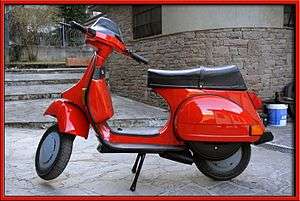Vespa T5
The Vespa T5 was a 125cc, single cylinder, 2 stroke scooter which was manufactured in the 1985-1999 period by Piaggio.
 | |
| Manufacturer | Piaggio |
|---|---|
| Also called | T5 |
| Predecessor | Vespa PX |
| Class | Road |
| Engine | 125 2-stroke, single cylinder, air-cooled |
| Bore / stroke | 55×52 mm |
| Compression ratio | 11.3/1 |
| Top speed | 100+ kmh |
| Power | 12.0 bhp @ 6,500 rpm |
| Ignition type | CDI |
| Transmission | 4-speed |
| Frame type | solo |
| Suspension | single sided (front and rear) |
| Brakes | Front and rear drum |
| Tires | 10 inch (front and rear) |
| Wheelbase | 1,235 mm |
| Weight | 112 kg (dry) |
| Oil capacity | premix 2 stroke oil for engine and 500 ml engine oil for gear box and clutch |
| Related | Vespa PX, Danmotor Excel 150 |
Engine
The Vespa T5 was a true sporting scooter featuring:
- a 5 port aluminum cylinder design with Nikasil plating
- a squarish (55 x 52 mm) and lightweight piston design
- a lightened flywheel
- a shorter 24mm carburetor (Dell'orto 24/24 G)
The T5 exceeded a top speed of 100 km/h (62 mph) as standard, easily comparing to the Vespa PX200; but its dependence on higher revs and relative lack of torque made it pale in adverse conditions, and/or with a pillion.[1]
On UK, and some entry-level Spanish and Italian models, premixing of 2 stroke oil was required; on French and German (and as an option in others) markets, autolube was standard, and accompanied by an electric start setup not available on base models.
The Vespa T5 had CDI ignition. Depending on the market, it either had no battery and all electrical components were powered by magneto after starting the engine. (UK, base models in Spain and Italy), or if a battery was fitted, it had an electric starter, and fuel gauge as well as horn were powered directly by DC (battery).
Body
Like classic Vespas, the scooter had full steel body panels and weighed around 112 kg dry. The engine was housed in the rear right side on a swing-arm and the left side housed a spare wheel. The rear brake was operated by a right foot pedal.
The T5 was sold in three generations:
- Vespa T5 Mk1 (1985-1992): Cosmetically, the Vespa T5 Mk1 featured a rectangular head light, an updated headset console which included a fuel level indicator and a digital or analog tachometer (depending on market), a flat rear end (achieved by adding the "square tail" sheet to a PX body), and a redesigned seat to complete the look. The front mudguard was smaller compared to the P-series mudguard and the steering head was attached to the fork via a locking ring instead of a handlebar-bolt. The scooter had a classic 4 speed manual left hand twist grip gear change, a kick starter, and a front storage compartment with a black tray atop it, adorned with a "Pole Position", logo, designed to underline its sportiness.
- Vespa T5 Classic (1992-1999): The T5 Classic had a standard Vespa PX frame but kept the T5 engine.
- Vespa T5 Millennium (1999): In 1999 Piaggio ended production of the T5. A numbered limited edition of T5 Millennium scooters would mark the end to the T5. The T5 Millennium saw the addition of a front disk brake.
Similar Scooters utilising the T5 Mk1 body
- Piaggio GS200: In Germany, the Benelux and Japan, Piaggio offered a similarly bodied version with a standard PX200 engine: the GS200.
- Motovespa PX125 T5 Sport: The Spanish T5 had the 5 port engine, a VIN starting with 98 and a plastic framed seat with a different seat pin.
- MotoVespa TX200: In Spain, MotoVespa offered a similarly bodied version with a standard PX200 engine: the TX.
- Piaggio&LML T5: The Indian LML Vespa T5 had a standard PX100, PX150 or PX200 engine. The T5-200 was destined for the Australian market. The LML T5 used a px type fork and front mudguard.
- LML Select & Select 2: is the successor of the LML Vespa T5, albeit with a standard PX150 engine, a redesigned console with no tachometer, and the steering head attached with a bolt instead of a locking ring.
- PT Danmotors Excel 150/200: Another similar scooter was manufactured by PT Danmotor of Jakarta, Indonesia.
- PGO V6: PGO Taiwan produced a 150cc clone, badged V6.